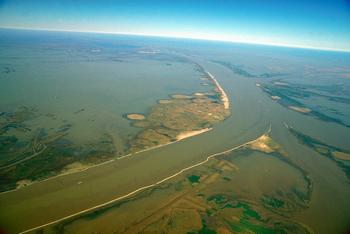最近剛出爐的一份研究報告顯示,儘管沿海海洋生態系普遍因人類不當活動而受到威脅。但全球最岌岌可危的沿海海洋生態系就在密西西比河口。

美國加州大學聖塔巴巴拉分校的科學家,首度對全球所有沿海地區進行了綜合性分析,並做出結論表示,從上游農場徑流下來的化肥成份夾帶在密西西比河中,最終注入墨西哥灣,是導致其淪爲全球沿海生態系污染最爲嚴重的罪魁禍首。
這些化肥物質促使藻類過度生長,剝奪水中其他海洋生物生存所需氧氣,最後造成墨西哥灣多處常態性死區。
任職於加州大學聖塔巴巴拉分校的國家生態分析及合成中心(National Center for Ecological Analysis and Synthesis),也是主導這項研究的哈爾佩恩(Benjamin Halpern)表示:「解決這些問題面臨最大的挑戰之一就是如何妥善分配有限的資源。」
「我們的研究結果明確指出,正視陸上污染源對沿海海洋生態造成的威脅刻不容緩。因此要標定出哪些是衝擊最嚴重的地點──也就是所謂的「熱點地帶」,以及哪些地方其污染源的影響很輕微,甚至可以不予理會。」
研究顯示,目前污染最嚴重的熱點地帶是在密西西比河口。該河口與其他9個分佈在亞、歐地區並列為污染最嚴重的沿海海洋生態系。
遭污染威脅第二嚴重的沿海海洋生態系,是恒河水道匯入孟加拉共和國的孟加拉灣内靠近達卡的鬆德班(Sunderbans)三角洲。
位居第三的是在靠近越南胡志明市,湄公河匯入南中國海一帶。
緊接著是中國的珠江,在香港附近注入南中國海域。意大利的波河在威尼斯附近海域流入亞得里亞海。其次是萊茵河和默茲河在荷蘭鹿特丹注入北海一帶。
作者針對驅動生態變化的4個關鍵陸上因素進行調查,分別為都市型農業化肥殘留物、使用農藥衍生的有機污染物、城市徑流的無機污染物、人類對沿海海洋棲地的直接影響等。
另外,作者在其論文中表示,全球和聯邦層級共同列出保育和管理辦法的優先次序,將有助於確定哪些國家最迫切需要解決其破壞海洋生態系的陸上污染源問題。
The world's most imperiled coastal marine ecosystem is at the mouth of the Mississippi River, although coastal marine ecosystems are at risk worldwide as a result of human activities, new research shows.
Scientists at the University of California-Santa Barbara who performed the first integrated analysis of all coastal areas of the world conclude the nutrient runoff from upstream farms that flows down the Mississippi River to the Gulf of Mexico is responsible for the most tainted coastal ecosystem in the world.
These nutrients have led to a persistent dead zone in the Gulf of Mexico caused by an overgrowth of algae that feeds on the nutrients and takes up most of the oxygen in the water, depriving other marine organisms of the oxygen they need to survive.
"One of the great challenges is to decide where and how much to allocate limited resources to tackling these problems," said Benjamin Halpern, the study's lead author, who is based at the National Center for Ecological Analysis and Synthesis at UC Santa Barbara.
"Our results identify where it is absolutely imperative that land-based threats are addressed - so-called hotspots of land-based impact - and where these land-based sources of impact are minimal or can be ignored," he said.
The hottest hotspot is at the mouth of the Mississippi River, the study shows, with the other nine most polluted coastal marine ecosystems in Asia and Europe.
The second most threatened marine coastal ecosystem is where the Ganges River drains into the Sunderbans delta in the Bay of Bengal near Dhaka, Bangladesh.
The third most imperiled coastal ecosystem is where the Mekong River empties into the South China Sea near Saigon, Vietnam.
Next are China's Pearl River where it meets the South China Sea near Hong Kong, Italy's Po River where it drains into the Adriatice Sea near Venice, followed by the Rhine and Meuse rivers that empty into the North Sea near Rotterdam in the Netherlands.
The authors surveyed four key land-based drivers of ecological change - nutrient input from agriculture in urban settings, organic pollutants derived from pesticides, inorganic pollutants from urban runoff, and direct impact of human populations on coastal marine habitats.
The authors state in their paper that both global-level and federal-level conservation and management prioritization efforts can benefit from identifying which countries are most in need of addressing land-based sources of impact to marine ecosystems.






